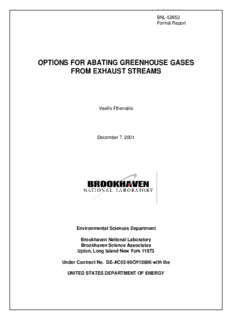
options for abating greenhouse gases from exhaust streams PDF
Preview options for abating greenhouse gases from exhaust streams
BNL-52652 Formal Report OPTIONS FOR ABATING GREENHOUSE GASES FROM EXHAUST STREAMS Vasilis Fthenakis December 7, 2001 Environmental Sciences Department Brookhaven National Laboratory Brookhaven Science Associates Upton, Long Island New York 11973 Under Contract No. DE-AC02-98CH10886 with the UNITED STATES DEPARTMENT OF ENERGY DISCLAIMER This report was prepared as an account of work sponsored by an agency of the United States Government. Neither the United State Government nor any agency thereof, nor any of their employees, not any of their contractors, subcontractors, or their employees, makes any warranty, express or implied, or assumes any legal liability or responsibility for the accuracy, completeness, or usefulness of any information, apparatus, product, or process disclosed, or represents that its use would not infringe privately owned rights. Reference herein to any specific commercial product, process, or service by trade name, trademark, manufacturer, or otherwise, does not necessarily constitute or imply its endorsement, recommendation, or favoring by the United States Government or any agency, contractor, or subcontractor thereof. The views and opinions of authors expressed herein do not necessarily state or reflect those of the United States Government or any agency, contractor or subcontractor thereof. Options for Abating Greenhouse Gases from * Exhaust Streams Vasilis Fthenakis Environmental Sciences Department Brookhaven National Laboratory Upton, NY 11973 ABSTRACT This report examines different alternatives for replacing, treating, and recycling greenhouse gases. It is concluded that treatment (abatement) is the only viable short-term option. Three options for abatement that were tested for use in semiconductor facilities are reviewed, and their performance and costs compared. This study shows that effective abatement options are available to the photovoltaic (PV) industry, at reasonable cost. * This work was performed under the auspices of the U.S. Department of Energy. i ii TABLE OF CONTENTS ABSTRACT........................................................................................................................i LIST OF FIGURES............................................................................................................v LIST OF TABLES............................................................................................................vii 1. INTRODUCTION........................................................................................................1 2. BACKGROUND ..........................................................................................................3 3. REVIEW OF ALTERNATIVES .................................................................................5 3.1 Substitution.........................................................................................................5 3.2 Process Optimization........................................................................................6 3.3 Capture and Recycling.....................................................................................7 3.4 Abatement of PFCs from Emission Streams................................................7 4. COMMERCIAL POINT-OF-USE ABATEMENT SYSTEMS ................................8 4.1. The BOC Edwards Thermal Processing System.........................................8 4.2 Plasma Abatement Systems...........................................................................9 4.2.1 Evaluation of the Litmas Plasma System...........................................10 4.3 Catalytic Decomposition Systems................................................................12 4.3.1 Evaluation of the Hitachi ThermoCatalytic Decomposition System.....................................................................................................14 5. DISCUSSION............................................................................................................15 6. ACKNOWLEDGEMENT..........................................................................................19 7. REFERENCES..........................................................................................................19 iii iv LIST OF FIGURES Figure 1. Comparison of different gases in chamber cleaning ................................5 Figure 2. A schematic of the NF3 remote system for chamber cleaning ...............6 Figure 3. The Edwards TPU System...........................................................................8 Figure 4. The Litmas PFC plasma abatement device.............................................10 Figure 5. Configuration of plasma PFC abatement system ...................................10 Figure 6. A schematic of ThermoCatalytic PFC abatement systems...................13 Figure 7. The Hitachi ThermoCatalytic Abatement System...................................14 v vi LIST OF TABLES Table 1. Characteristics of Some Common Etching Compounds...........................2 Table 2. Atmospheric Lifetimes and Global Warming Potentials (GWPs) of Selected Greenhouse Gases....................................................................4 Table 3. Summary Comparison of PFT Abatement Systems................................17 vii viii
Description: